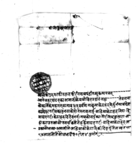A letter from Raṅganātha Pauḍyāla to the amālī of Patan re the term of boys who perform at the Kārttika dance (VS 1894)
ID: E_1949_0028
Edited and
translated by Simon Cubelic, Rajan Khatiwoda
in collaboration with
Ramhari Timalsina
Created: 2016-10-11;
Last modified: 2018-06-23
For the metadata of the document, click here
The accompanying edition, translation/synopsis and/or commentary are available under the terms of the Creative Commons Attribution-ShareAlike 4.0 International License
Abstract
In this letter Guru Paṇḍitarāja Raṅganātha Pauḍyāla orders the Patan amālī responsible for doing so to make sure that the decreed three-year term for boys performing at Patan’s Kārttika-Nāc is enforced.Diplomatic edition
[1r]
श्री\सिद्धिनरसिंहराज[Seal of Guru Paṇḍitarāja Raṅganātha Pauḍyāla]1स्वस्तिश्रीगुरुपण्डीतराजश्रीरंगनाथपंडीतज्यूकस्यपत्रम्¯ ¯ ¯ ¯ ¯2आगे•सहरपाटन्काअमालीकेयथोचित्उप्रांत•ताहा¯ ¯ ¯ ¯ ¯लेवनाया
3कोकार्तिक्महातम्कानाच३।३वर्षमानाचन्याकेटाहरूफेर्नुभंन्यावंदेज
4कामोहरगरीवक्सनुभयाकोहो•तेसनाचलाई•चाहिन्याकेटाहरुलिदा•हि
5मायत्गरीकेटाहरुदिदैनभनी•नाचकोनाईक्या•गौरीनाथव्राह्मण•ञाँ
6हाँ•कराउनआयो•तसर्थ•कसैले•हर्हिमायत् गरी•चाहिन्याकेटाहरु•अ
7टकायोभन्या•अमालीले•अडियाकोकेटाझिकीदिनूईति•सम्वत१८
8९४सालमितिपौषवदि३०रोज४शुभंम्¯¯¯¯¯¯¯¯¯¯¯¯¯¯¯
Translation
[1r]
Śrī
The Venerable King Siddhinarasiṃha
[Seal of Guru Paṇḍitarāja Raṅganātha Pauḍyāla]
Hail! [This is] a letter from the Venerable Guru Paṇḍitarāja, the Venerable Raṅganātha Paṇḍita.
To the amālī of the city of Patan
Yathocita uprānta: The Brahmin Gaurīnātha, who is the head of the [Kārttika] dance, came here to complain, saying: “A decree has been issued that the boys who perform the Kārttikamāhātmya dance instituted by -- (i.e. the Venerable King Siddhinarasiṃha) there [in Patan] shall be replaced every three years. When the boys needed for that dance are being taken [away], [some persons] contemptuously do not provide their boys.” Therefore, [if] someone out of sheer contempt prevents the needed boys [from dancing], the amālī shall haul forth the boys who have been held back.
Wednesday, the 30th of the dark fortnight of Pauṣa in the [Vikrama] era year 1894 (1838 CE). Auspiciousness.
Commentary
The event referred to here is the Kārttika or Narasiṃha dance (nāca) performed in Patan during the month of Kārttika. It was instituted by King Siddhinarasiṃha Malla of Patan (1619–1661) as part of his religious policy of spreading and consolidating Kṛṣṇaism in Nepal (Lienhard 1992: 229). Not coincidentally, it takes place at that time of year associated with many Krṣṇaitic festivals (Lienhard 1992: 231). All this is reflected in what the dance is called in the Padmagiri Chronicle: Kṛṣṇalīlā (Hasrat 1970: 69). The performances in question here, however, have to do with different emanations (avatāra) of Viṣṇu and do not specifically focus on Kṛṣṇa (Kropf 2003: 82 n. 18). The successor of Siddhinarasiṃha, King Śrīnivāsa Malla, is credited with extending the dancing period by ten days to twenty-five days in total (Bajracharya/Gutschow/Michaels 2015: I 127). According to Siegfried Lienhard, originally its duration was one month, but in later times it was reduced to ten days (Lienhard 1992: 231).

